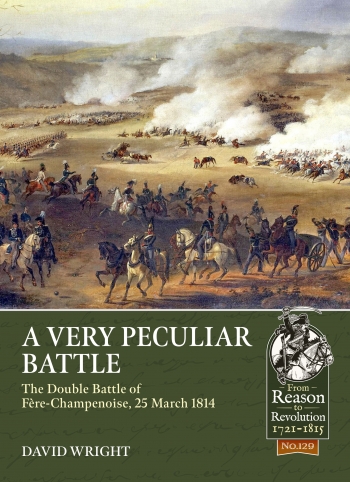A VERY PECULIAR BATTLE
The Double Battle of Fère-Champenoise, 25 March 1814
Autore: David Wright
Codice: 283441
From Reason to Revolution 1721-1815 #129
La peculiare storia dello scontro, unico nel suo genere, di Fère-Champenoise durante le Guerre Napoleoniche, tra le forze di Napoleone e la coalizione russo-austriaca: due battaglie separate che si fusero insieme.
---
A Very Peculiar Battle tells the story of a unique battle in the Revolutionary and Napoleonic Wars. Fère-Champenoise was two separate battles that merged together. In one, a force of Russian, Württemberg, and Austrian cavalry and horse artillery defeated a larger French force of infantry, cavalry and artillery, opening the way to Paris. In the other, Russian cavalry and horse artillery destroyed Napoléon’s last supply column.
Fère-Champenoise was a far more significant battle than is usually portrayed. Napoléon, after a string of victories in February 1814, had been defeated by superior numbers, first by Feldmarschall Blücher at Laon (9–10 March), then by Feldmarschall Schwarzenberg at Arcis-sur-Aube (20–21 March). Napoléon then gambled on a manoeuvre sur les derrières, moving onto Schwarzenberg’s line of communications and intending to join with troops from his border fortresses and Lyon to force a battle on ground of his choosing.
The allies started to follow, but Emperor Alexander of Russia made a crucial decision on March 24 for the allied armies to ignore Napoléon and head for Paris. The next day, allied cavalry and horse artillery led by the Crown Prince of Württemberg defeated a larger force of the corps of Maréchaux Marmont and Mortier, the last formed French troops barring the way to the capital. This enabled Schwarzenberg’s and Blücher’s armies to combine, defeat the last defenders of Paris, and force the city's surrender before Napoléon could return, allowing the allies to negotiate the end of the campaign without the Empereur being able to participate.
At the same time, a convoy of ammunition and supplies, escorted by the two weak Gardes nationaux divisions of Généraux de division Pacthod and Amey, and trying to find Maréchal Mortier, moved into the path of the advancing Russo-Prussian army. After a heroic retreat, attacked by Russian cavalry and horse artillery, the two divisions were forced to surrender, losing all their vehicles and guns.
The battle was unique in the Revolutionary and Napoleonic Wars. It was two separate battles that merged into one, as both defeated French forces retreated towards the town of Fère-Champenoise, one from the east and the other from the northeast. Four different armies were involved: the main battle between units from the allies’ Hauptarmee and the French Armée de l’Aisne and the secondary one between units from the allies’ Schlesische Armee and a convoy from Maréchal Macdonald’s XI Corps d’Armée, part of Napoléon’s Grande Armée.
Both were encounter battles in that all four armies involved were unaware of the presence of their opponent until they met. In both battles, the allied forces consisted entirely of cavalry and horse artillery, while the French forces contained predominantly infantry and foot artillery. A French force of ligne and garde units panicked, while a force of ill-trained Gardes nationaux fought stubbornly until overwhelmed. During the main battle, a short, violent storm had a devastating effect on the French, while the arrival of the secondary battle prevented the main from being an overwhelming success.
INGLESE
9 illustrazioni in bianco e nero, 20 a acolori, 10 foto a colori e 34 mappe
226
18 x 25


